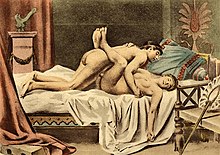Erotica


Erotica (from the Greek ἔρως, eros "desire") are works of art, including literature, photography, film, sculpture and painting, that deal substantively with erotically stimulating or sexually arousing descriptions. The term is a modern word that describes the portrayal of the human anatomy and sexuality with high-art aspirations, differentiating such work from commercial pornography.[1] Curiosa generally refers to erotica and pornography as discrete, collectible items, usually in published or printed form.
Erotica and pornography

Distinction is often made between erotica and pornography (the depiction of acts in a sensational manner so as to arouse a quick intense reaction) (as well as the lesser known genre of sexual entertainment, ribaldry), although depending on the viewer they may seem one and the same. Pornography's objective is the graphic depiction of sexually explicit scenes.[2] Pornography is often described as exploitative or degrading.[2][3]
See also
References
- ^ "Pornography". Encarta. Archived from the original on October 31, 2009.
{{cite web}}: Unknown parameter|deadurl=ignored (|url-status=suggested) (help) - ^ a b "Erotica Is Not Pornography". William J. Gehrke. The Tech. December 10, 1996.
- ^ "Don't confuse erotica with porn". Jug Suraiya. The Times of India. August 15, 2004.
